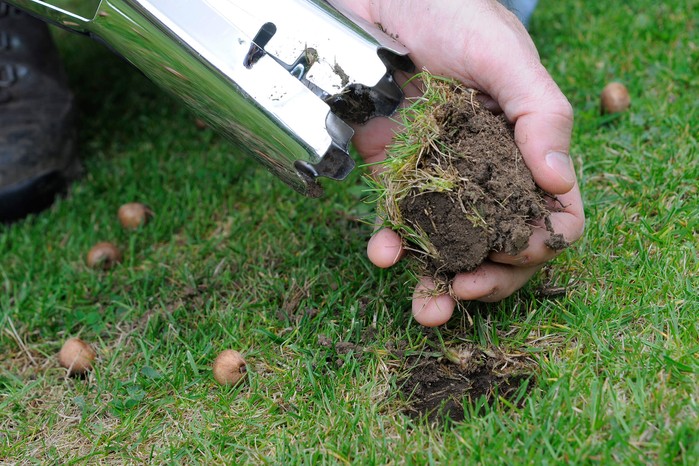
Crocuses bring a burst of colour to the garden in spring and autumn. Carpets of the small purple, yellow and white flowering corms make a joyful display from late winter onwards. They also provide a much-needed source of nectar and pollen for pollinating insects just emerging from hibernation. Native to Eastern Europe, crocuses are easy to grow spring bulbs and are well-suited to growing in pots, and naturalising in grass.
How to grow crocuses
Plat crocus corms in moist but well-drained soil in full sun, planting the corms at a depth of three times their own size. You can grow crocus at the front of a border, naturalised in grass or in pots. Always let the foliage die back completely after flowering.
More on growing crocuses:
When to plant crocus bulbs
Plant crocus bulbs in autumn, from September to November. You can get away with planting crocuses up to Christmas, as long as the bulbs remain firm and have not developed mould, but you may find they flower later than they would normally. You can plant pots of pre-grown spring crocuses in spring for a quick burst of colour, but any bulbs left over from autumn are likely to have gone soft and mouldy by spring, and will therefore not be viable for planting. However the autumn crocus, Colchicum autumnale, can be planted in spring.
Where to plant crocuses
Most crocus varieties need to be planted in a sunny, open position. They’ll successfully naturalise in grass to make a lovely spring meadow. Certain species, such as Crocus gargaricus, need moist but well-drained soil and will grow in partial shade too.
Crocuses can be grown in pots, either on their own, or mixed with other spring-flowering bulbs. Add plenty of grit for drainage.
How to plant crocuses
How to grow crocuses – planting crocus bulbs in a lawn
Plant crocuses in well-drained or very gritty and free-draining soil or compost. Saffron crocus and other autumn flowering varieties need to be planted quite deep – about 10cm in well-drained, rich soil in a sunny situation and 7.5cm apart. There’s no need to pre-soak crocus bulbs before planting.
Make sure you plant your crocus corms with pointed tip facing upwards and the flattened end at the bottom of your planting hole.
In this Gardeners’ World clip, Monty Don explains how to plant crocuses in a border:
Here, Kevin Smith explains how to layer crocuses with other bulbs in a pot:
In this No Fuss video guide. Alan Titchmarsh explains how to naturalise crocuses in a lawn:
How to care for crocuses

How to grow crocuses – Crocus ‘Jeanne Darc’
If you have crocuses that have naturalised in grass, don’t cut the lawn until the flowers have died and the leaves have yellowed and disappeared.
Spring-flowering crocus come into flower as the sun warms up the soil. However, autumn-flowering crocuses respond to decreasing soil temperatures. So, in milder autumns, flowering may not be so vigorous if the nights aren’t cool enough.
How to propagate crocuses
Crocuses will multiply once established and create their own colonies. If you want to propagate your collection, dig up large clumps in autumn and split them into smaller ones, or clean off individual corms and pot up.
More like this
Growing crocuses: problem solving

How to grow crocuses – pot of planted crocus bulbs covered in chicken wire
Crocuses are relatively trouble-free, although newly planted bulbs may fall prey to hungry squirrels in the autumn, so it’s worth netting grassy areas, or covering pots with wire mesh.
Advice on buying crocuses
- Always make sure you buy from a reputable supplier
- Choose spring crocuses for spring flowering and autumn crocuses for autumn flowering
- Check bulbs before planting and discard any soft or mouldy ones
Where to buy crocuses
Crocus varieties to try

How to grow crocuses – Crocus sativus
- Crocus ‘Violet Queen’ – a beautiful deep-violet, spring flowering cultivar
- Crocus x culturum ‘Jeanne d’Arc’ – one of a group of Dutch hybrids with larger corms that can be planted deeper in the ground and in thicker grass. Flowers are white with purple staining
- Crocus tommasinianus ‘Whitewell Purple’ – a cultivar with pale purple flowers on strong stems, grows well in herbaceous borders
- Crocus sativus – the saffron crocus produces purple flowers in autumn. The bright red style at the centre of the flower produces the delicate yellow strands of cooking saffron. But you need around 150 flowers to produce one gram. They need digging up and replanting into fresh soil every 4-5 years
- Crocus speciosus ‘Albus’ RHS AGM – an all white form of this autumn flowering species. It suits light shade or can be planted under deciduous shrubs. Plant in late summer to flower in September/October
